After Coal: Stories of Survival in Appalachia and Wales
Air Date: Week of January 17, 2020

Picture of a Kentucky Mine Supply building in downtown Harlan. To this day, protests over unpaid Kentucky coal miners continue. (Photo: Tom Hansell)
Communities in Appalachia have been hit hard economically as coal production has dropped, leaving miners out of work, and their communities with shrunken tax bases and fewer paying customers for local businesses. It’s a story that has also played out in Wales in the UK. The experiences on both sides of the Atlantic are the theme of Tom Hansell’s new book, “After Coal: Stories of Survival in Appalachia and Wales”, also a documentary. The book and film tell the story of the After Coal Project, an initiative that seeks to bridge former Appalachian and Welsh coal mining communities. Tom Hansell joins Host Steve Curwood to talk about how the After Coal Project is helping breathe new economic and cultural life into these regions.
Transcript
CURWOOD: Some of the fiercest opposition to climate action in the US has come from regions that built their economies on fossil fuel extraction. Think Texas and Oklahoma for oil and gas and especially Wyoming Kentucky, West Virginia, Pennsylvania, and Ohio for coal. Those regions have been hit hard economically as coal production dropped, leaving miners out of work, and their communities with shrunken tax bases and fewer paying customers for local businesses. It’s a story that has also played out in Wales in the UK. The experiences on both sides of the Atlantic are the theme of Tom Hansell’s new book, After Coal: Stories of Survival in Appalachia and Wales. Tom Hansell joins me now for more. Tom, welcome to Living on Earth!
HANSELL: Glad to be here.
CURWOOD: So, Tom, how did you get involved with the story of After Coal?
HANSELL: I learned about this long-term exchange that had been started by, through the center for Appalachian studies here and learned that they were bringing students and community members over to South Wales where the coal mines had shut down in the 1980s. And so I thought that would be really interesting to go over, gather stories of how those communities had survived, bring them back to Appalachia, and start an international conversation about how communities can survive the loss of the main industry that, that they were built around.
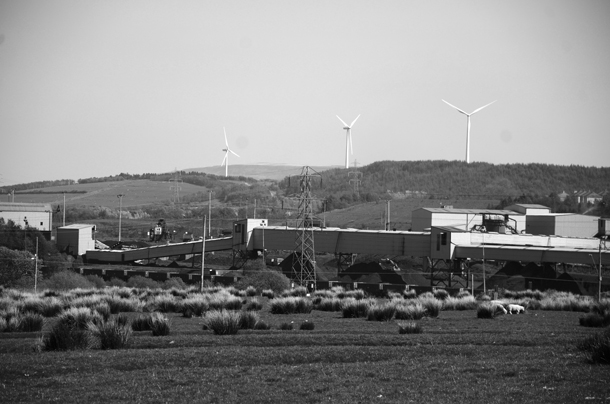
A coal washery windfarm at Onllwyn, Wales. (Photo: Tom Hansell)
CURWOOD: Now, one of the most interesting parts of your reporting here, Tom, is about the unions. And in both places, unions have been a major part of how these coal communities’ function. And one of the things that's really interesting about the union phenomenon, it's, it's like a huge, almost secular society of the people who live in these communities. They literally provide meeting places but it's a way that everyone relates. So talk to me a little bit about the history of that and how communities today can fill up that space.
HANSELL: I was really interested to learn that in Wales, the unions were not just doing these gathering spaces you were talking about and building political power for the miners, but they were also providing continuing education services. There was a whole system of miners' libraries and free courses after hours so that miners could continue their education and fully participate in, in civic life, which I thought was really interesting. And then other kind of cultural aspects of the unions including male voice choirs or brass bands are big things happening in the UK. In Appalachia, union halls also very much community gathering places, places where local foods are celebrated, places where you can hear great traditional music. But the difference between the actually complete domination closed shop and nationalized industry in the UK and the private industry and the, the lesser power of the unions in the United States was also pretty much a stark contrast. So I think the key question that you asked, looking for the future, is these social spaces, these cultural spaces, these democratic spaces, for the most part, were built up around this industry, and what is there to take their place when the industry crumbles? And I think that's really important. I think people are still gathering sometimes in churches or chapels, sometimes around arts projects. There were some interesting arts projects, particularly the higher ground of Harlan County project that I followed in Eastern Kentucky that provided really interesting ways for diverse groups of people to participate in making something new that spoke to their identity and their history and their hopes for the future. I think there's, there is a lot of community life happening, but it's perhaps a lot more dispersed than it was in the days when union halls were the place that you went to see your neighbors and to get together.
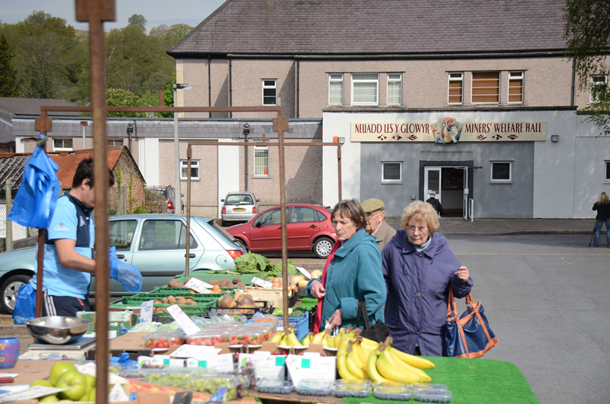
The local market in Ystradglynlais, a Welsh mining community. (Photo: Tom Hansell)
CURWOOD: You spend quite a bit of time in your book talking about how essential it is to support communities and help them prosper for our overall society to stay stable. So in this time of the climate crisis, with the potential for so many more communities to get left behind in the energy transition, how do we support those communities affected by taking the economy greener and climate disruption?
HANSELL: I'm glad you brought that up, because that is actually one of the central points that the After Coal Project tries to address and obviously, we have to address the climate issue. That's what the science tells us. And it's crucial to do it sooner rather than later. At the same time, I believe that the only way to get deep and lasting solutions is to reach out very first to people that have been part of an extractive economy, whether that's the oil fields, or the gas fields or the coal fields. These places that have been built up around a single industry need other options, and sometimes and maybe need some extra support. I would argue that particularly in the case of the coalfields, the coal fields power of the United States, for most of the 20th century. There was coal that helped us win world wars, there was coal that helped build the strongest industry and economy in the world. And very little that wealth was left behind. Most of that wealth went to corporations that were headquartered outside of the coal fields. And there needs to be some system where some of that wealth gets returned and some of the opportunities that coal provided to the nation get returned and focused back in the coal fields. Especially important as those jobs are being lost and as we're experiencing this shift from a fossil fuel powered economy to a greener economy. It's really crucial to bring the most vulnerable populations along.
CURWOOD: One way that you cite that is helping to restore these communities is the power of things like local food and the arts. Talk to me a bit about that.
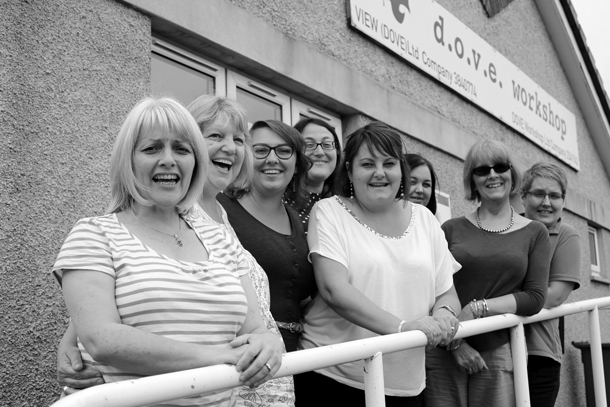
Women of the DOVE workshop, which is aimed at helping workers left behind by a global economy in the South Wales Coal Mines. (Photo: Tom Hansell)
HANSELL: I was actually really impressed at the amount of local farming that's sprung up really during the time of the After Coal Project. My last project was actually looking at the controversy around a coal-fired power plant in southwestern Virginia. In Wise County, Virginia. That plant eventually was built. It's actually one of the most recent coal-fired power plants built in the US. And as a result, I wanted to do these public forums in Wise County and was working with local organizations to talk about what a greener energy future might look like there. So I called them the Wise Energy Forums. But it was interesting at those forums, people wanted to talk about farming and agriculture and local foods. And it took me a while to listen and to understand that when they were talking about diversifying the economy, that's where they saw their assets, and that that was really important to follow their lead. And what's happened since that time and even since the time the After Coal Project is gone, is that local foods and local agriculture have really exploded in the coal fields. There is a former miner name's Shane Lucas, who created a small farm on his family's land, was connected with a network of farmers markets. And now that that network is actually expanded, this is in Letcher County, Kentucky. And they have a project where the local health care agency was able to use some of the Medicare expansion funds to offer kind of like tokens, but prescriptions for fresh vegetables from the farmers market. So they give their patients tokens to get fresh vegetables. The patients can go down, turn in those tokens to the local farmers like Shane Lucas, the former miner, and then the local farmers bring them back to the health care provider and get paid in cash. And so what you end up doing is dealing with issues like diabetes by increasing the amount of fresh vegetables, dealing with issues like economic development by supporting local farmers and supporting the local health care industry. So I think that's a really fascinating example and one that I didn't get a chance to get into as deep in the After Coal book, but it's really nice for me to see these projects grow and build from the coal fields.
CURWOOD: Now how did having the people in Appalachia and in the southern part of Wales, in those communities that used to do largely coal, how did it help these folks move forward when they got together, when they did these exchanges, when they went to visit each other and their places?
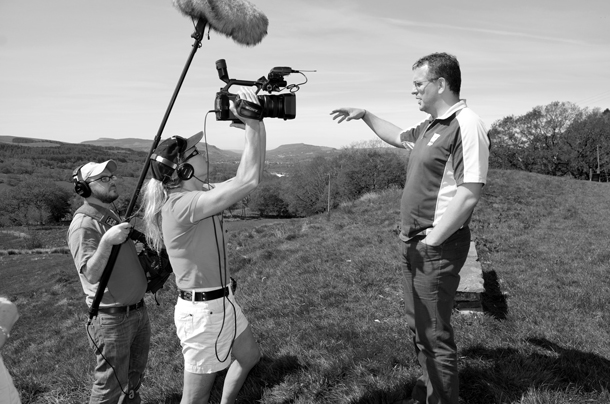
Filmmaker Tom Hansell (left) and Suzanne Clouseau (center) interviewing Geraint Lewis (right) in Abercraf, Wales where in 1966 an avalanche of coal waste killed 144 people. (Photo: Tom Hansell)
HANSELL: That transition was going on whether the After Coal Project was happening or not. I'd like to think it perhaps provided people a way to reflect, maybe provided some new ideas, some ways to brainstorm. I think, ultimately, you know, if you look at the per capita income in each place, it hasn't dramatically changed since I've done the After Coal Project. But I do think that the economy has diversified. And I would say that both these conversations and the After Coal Project as a whole, have increased the recognition of locally-driven organizations that are doing the work. So I've for example, spend a lot of time with the Dove Workshop in Banwen, Wales, an educational workshop that now has a small restaurant catering, business and childcare business all opened in a former coal mine office. Likewise in Appalachia I was able to work with the southern Appalachian labor school in Oak Hill, West Virginia. They actually have taken over a former school in that town that had closed down due to school consolidation. And we did things like a fundraising dinner and film screenings. Working with the Apple Shop Media Arts Center in eastern Kentucky, we did a music exchange where we brought musicians from Wales over to their annual festival, the seat time on the Cumberland festival and did a performance and a discussion there. We also brought performers from Appalachia over to Wales to the Hay Festival and did a performance and discussion. So you know, in terms of a bottom line, how much it's increased the per capita income, I'm not sure we can measure that. In terms of how it's participated in building a movement and supported the people that are in these communities on the ground doing the work, I feel pretty good about that.
CURWOOD: I'd love to hear some of the music that you had in those exchanges.
HANSELL: Yeah, I think the piece that I will definitely share with you all was a performance that took a song that originated in Wales as a hymn called Calon Lan was brought over to the United States and became a bluegrass gospel song that you might be familiar with called Life's Mountain Railroad. And that's a really fascinating story, and you can hear it in the melody of that song.
CURWOOD: Let's take a listen.
[MUSIC: Frank Hennessy, Lolo Jones, Trevor McKenzie and Rebecca Branson Jones, medley based on "Calon Lan." ]
CURWOOD: So this is not a fair question Tom, but here it comes.
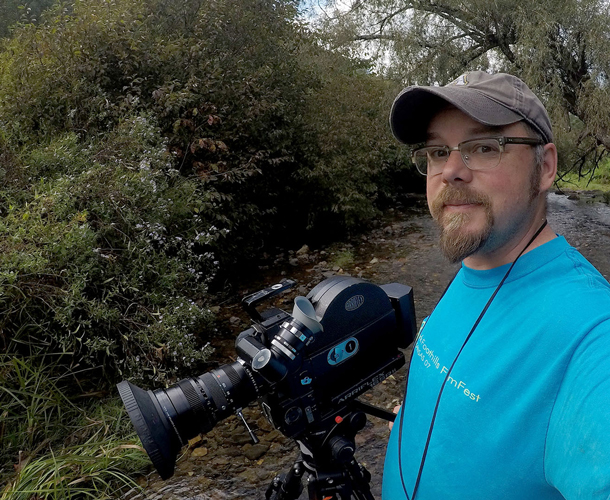
Tom Hansell is an award-winning filmmaker and author of After Coal: Stories of Survival in Appalachia and Wales. (Photo: Tom Hansell)
HANSELL: Yeah. All right.
CURWOOD: In the end, what, what do you think these communities in Wales and Appalachia got out of the After Coal Project?
HANSELL: I think the first thing is the people that directly participated in the project, there were dozens on each side in Appalachia and Wales, I think gained a little bit of a deeper understanding and appreciation of not just their own communities, culture and history, but how it connects to and relates to other culture and history. I think, also, that a lot of people did actually get the opportunity to travel. There were several people that we were able to bring back and forth and I think it will be interesting to see what happens next. There's definitely talk of a youth media exchange. And there's actually two reporters from West Virginia Public Broadcasting that have recently gotten a grant to go over to Wales and explore a little more of this idea of Life After Coal. I think that there have been some lasting connections that have been made and that will continue to be fruitful, hopefully over the next decade or two or three.
CURWOOD: Tom Hansell's book and documentary projects are called After Coal: Stories of Survival in Appalachia and Wales. Tom, thanks so much for taking the time with us today.
HANSELL: Thanks for having me.
Links
Living on Earth wants to hear from you!
Living on Earth
62 Calef Highway, Suite 212
Lee, NH 03861
Telephone: 617-287-4121
E-mail: comments@loe.org
Newsletter [Click here]
Donate to Living on Earth!
Living on Earth is an independent media program and relies entirely on contributions from listeners and institutions supporting public service. Please donate now to preserve an independent environmental voice.
NewsletterLiving on Earth offers a weekly delivery of the show's rundown to your mailbox. Sign up for our newsletter today!
 Sailors For The Sea: Be the change you want to sea.
Sailors For The Sea: Be the change you want to sea.
 The Grantham Foundation for the Protection of the Environment: Committed to protecting and improving the health of the global environment.
The Grantham Foundation for the Protection of the Environment: Committed to protecting and improving the health of the global environment.
 Contribute to Living on Earth and receive, as our gift to you, an archival print of one of Mark Seth Lender's extraordinary wildlife photographs. Follow the link to see Mark's current collection of photographs.
Contribute to Living on Earth and receive, as our gift to you, an archival print of one of Mark Seth Lender's extraordinary wildlife photographs. Follow the link to see Mark's current collection of photographs.
 Buy a signed copy of Mark Seth Lender's book Smeagull the Seagull & support Living on Earth
Buy a signed copy of Mark Seth Lender's book Smeagull the Seagull & support Living on Earth

